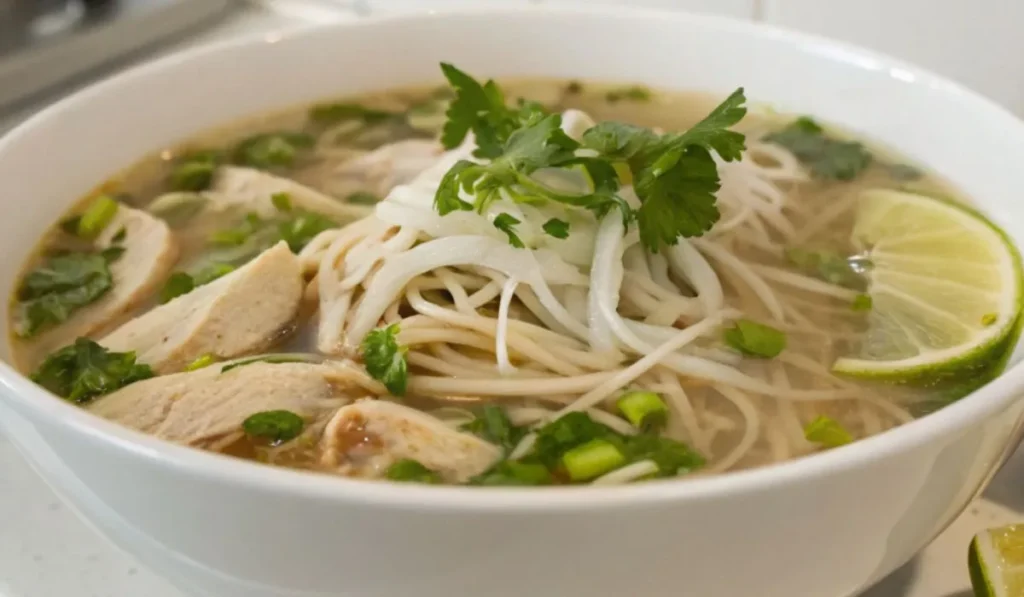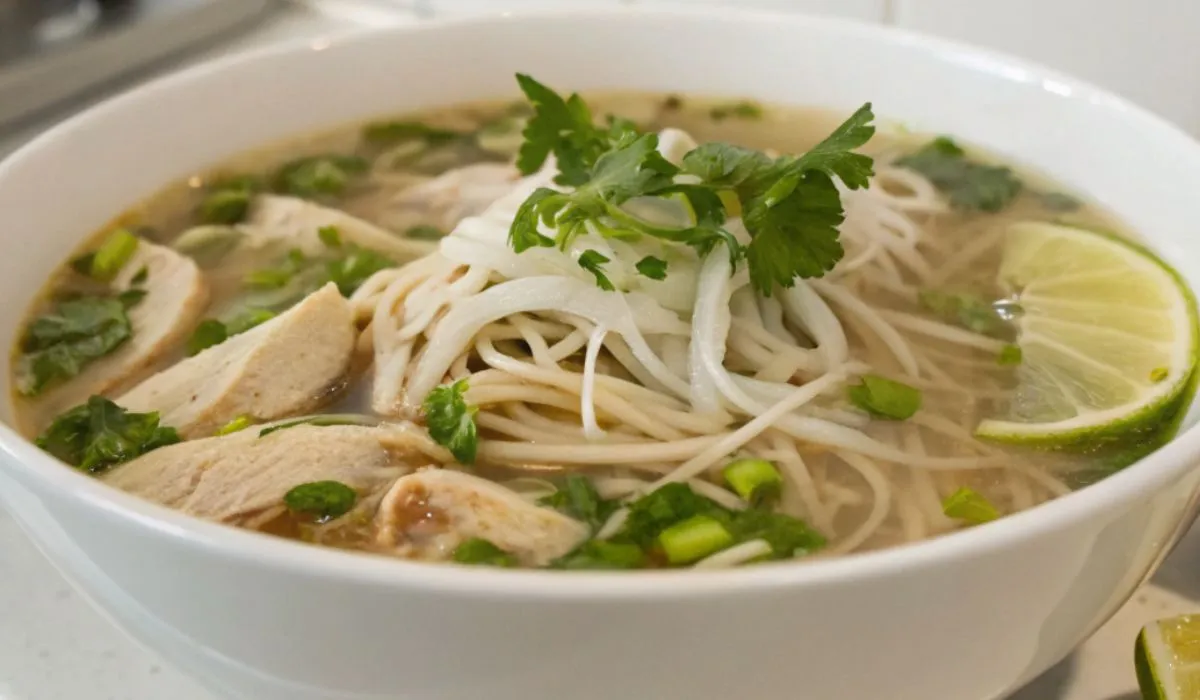This easy pho recipe brings the authentic flavors of Vietnamese noodle soup to your kitchen without spending hours simmering bones.
As someone who has made this comforting soup dozens of times for my family, I can tell you that this quick version delivers the same warm, aromatic experience you’d find at your favorite Vietnamese restaurant.
The secret lies in building layers of flavor with the right spices and fresh garnishes that make each bowl incredibly satisfying.

Essential Pho Ingredients
Creating delicious pho starts with gathering the right ingredients that work together to build that signature Vietnamese flavor profile.
For the Broth:
- 6 cups chicken (or beef, vegetable broth)
- 2 cups water
- 1 large yellow onion, quartered
- 2 pieces fresh ginger (2-inch pieces), halved lengthwise
- 1/4 teaspoon ground coriander
- 1 whole clove
- 1 1/2 tablespoons fish sauce
- 1/4 teaspoon hoisin sauce
- 1/4 teaspoon soy sauce
- 1/4 teaspoon red chili paste
- 1 cinnamon stick
- Salt and black pepper to taste
For the Noodles and Protein:
- 8 oz dried rice vermicelli noodles
- 1/2 lb thinly sliced beef, chicken, pork, or raw shrimp
Fresh Garnishes:
- 4 green onions, chopped
- 2 jalapeño peppers, thinly sliced
- Fresh cilantro bunch
- Thai basil leaves
- 1 cup bean sprouts
- 2 limes, cut into wedges
- Sriracha sauce
How to Make Vietnamese Pho
Follow these step-by-step instructions to create restaurant-quality pho soup at home.
Building the Aromatic Broth:
- Heat a large pot over medium heat and add quartered onion and ginger pieces
- Cook for 4 minutes, stirring occasionally to char slightly
- Add broth, water, coriander, clove, fish sauce, hoisin sauce, soy sauce, chili paste, and cinnamon stick
- Bring to a slow boil, then reduce heat and simmer for 30 minutes
- Season with salt and pepper to taste
Preparing the Components:
- Cook rice noodles according to package directions until tender
- Drain, rinse with cold water, and set aside
- Arrange all garnishes in small bowls for easy serving
- Slice your chosen protein as thinly as possible against the grain
Final Assembly:
- Add sliced meat to the simmering broth 1-5 minutes before serving
- Cook until just done (2-3 minutes for chicken/pork, 1-2 minutes for beef/shrimp)
- Remove and discard the ginger, onion pieces, clove, and cinnamon stick
- Divide cooked noodles among serving bowls
- Ladle hot broth and meat over the noodles
- Serve immediately with garnish bowls on the side
Pro Tips for Perfect Pho
These expert techniques will elevate your homemade pho to restaurant quality.
Meat Preparation Secrets:
- Freeze meat for 1 hour before slicing for paper-thin cuts
- Always slice against the grain for tender bites
- Season protein with salt and pepper before cooking
- For pork, sear the tenderloin first, then slice after resting
Broth Enhancement Tips:
- Char the onion and ginger for deeper flavor
- Taste and adjust fish sauce gradually
- Simmer longer for more concentrated taste
- Strain the broth for clearest presentation
Popular Pho Variations
Different protein choices create distinct pho experiences that cater to various preferences.
Pho Bo (Beef Pho):
- Use beef broth as your base
- Choose sirloin, flank steak, or brisket
- Slice extremely thin for quick cooking
- Popular choice at Vietnamese restaurants
Pho Ga (Chicken Pho):
- Start with chicken broth
- Use boneless, skinless chicken breasts
- Cook just until no longer pink
- Lighter, more delicate flavor profile
Vegetarian Pho Options:
- Substitute vegetable or mushroom broth
- Add sautéed mushrooms and baby bok choy
- Omit fish sauce for vegan version
- Include extra herbs and vegetables
Make-Ahead and Storage Tips
Smart meal prep strategies help you enjoy fresh pho anytime during busy weeks.
Advance Preparation:
- Make broth up to 3 days ahead and refrigerate
- Prep all garnishes and store separately
- Cook noodles just before serving for best texture
- Reheat broth gently on the stovetop
Freezing Instructions:
- Freeze only the finished broth for 4-5 months
- Cool completely before transferring to freezer bags
- Thaw overnight in refrigerator before reheating
- Fresh noodles and garnishes work best
Serving Your Homemade Pho
The presentation and garnish selection make pho soup truly shine as a complete meal experience.
Traditional Serving Style:
- Use deep soup bowls to hold generous portions
- Arrange garnishes attractively in small dishes
- Provide chopsticks and Asian soup spoons
- Let diners customize their own bowls
Garnish Combinations:
- Squeeze lime juice over the hot broth
- Add herbs according to personal taste
- Include bean sprouts for satisfying crunch
- Adjust heat level with chili paste or sriracha
This simplified pho recipe proves that you don’t need hours of cooking time to create an authentic Vietnamese dining experience.
The combination of aromatic broth, tender noodles, and fresh garnishes delivers comfort in every spoonful while bringing families together around the dinner table.

Easy Vietnamese Pho Soup
Ingredients
Equipment
Method
- Place a large dry pot over medium heat. Add the onion halves and ginger pieces. Cook for 4 minutes, stirring occasionally to char slightly.
- Add the broth, water, coriander, clove, fish sauce, hoisin sauce, soy sauce, chili garlic paste, cinnamon stick and a pinch of fresh cracked salt and pepper to the pot. Bring to a slow boil, then reduce heat and simmer for 30 minutes.
- Meanwhile, prepare rice noodles according to package instructions. Once soft, drain, rinse with cold water and set aside.
- Ready the garnishes in individual small bowls for serving: cilantro, basil, green onions, bean sprouts, lime wedges and sliced chilies.
- 1-5 minutes before the broth is done cooking, add desired meat to the broth to cook, just until done (2-3 minutes for raw, thinly sliced chicken or pork, 1-2 minutes for shrimp or thinly sliced steak).
- Discard the ginger, clove, cinnamon stick and onion pieces from the pot using a strainer or slotted spoon.
- Divide the cooked noodles among serving bowls and ladle hot broth and meat over the top. Serve immediately with garnish bowls on the side for customization.
